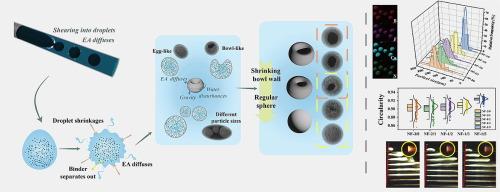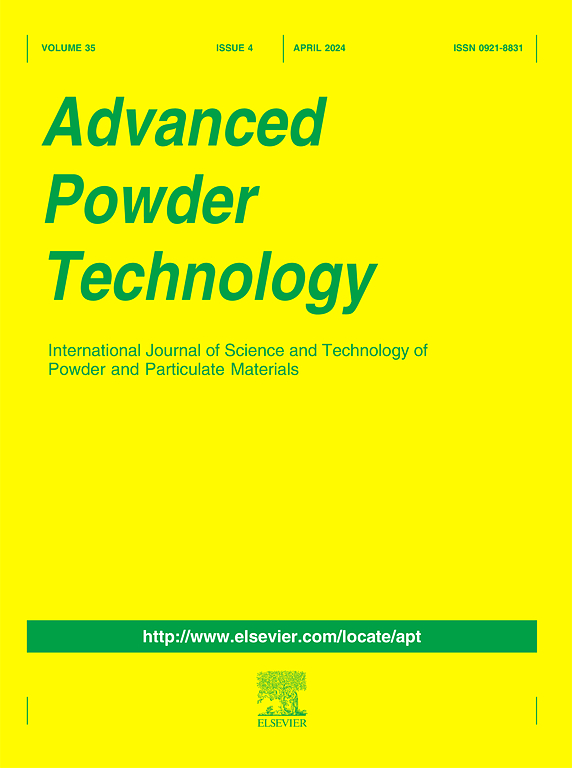通过粘合剂协同作用调节自组装微球的结构和性能
IF 4.2
2区 工程技术
Q2 ENGINEERING, CHEMICAL
引用次数: 0
摘要
复合高能材料结构对燃烧和爆轰性能起着至关重要的作用。本研究采用液滴微流体技术(DMT),以硝化纤维素(NC)和氟橡胶(F2604)为粘结剂溶液,制备了形态规整、元素分布均匀、圆度高、装药性能良好的硼(B)/氧化铜(CuO)复合微球。系统研究了粘合剂协同作用对微球结构、热性能、机械敏感性和燃烧性能的影响。结果表明,微球的表观和内部结构以及尺寸可通过调整粘合剂比例和氟橡胶浓度来调节。这种调整可使微球从碗状转变为球状,从而改善其充电性能。此外,在调整粘合剂后,样品的放热峰值和输出火焰温度呈现出规律性变化,从而实现了燃烧速度的可控调节。这项研究深入揭示了粘合剂协同作用如何影响高能微球的结构和性能,为制备其他复合高能材料提供了有价值的参考。本文章由计算机程序翻译,如有差异,请以英文原文为准。

Regulation of self-assembled microsphere structure and performance through binder synergy
Composite energetic material structure plays a critical role in combustion and detonation performance. In this study, boron (B)/copper oxide (CuO) composite microspheres with regular morphology, uniform elemental distribution, high circularity, and good charging performance were prepared using droplet microfluidic technology (DMT) with nitrocellulose (NC) and fluorine rubber (F2604) as binder solutions. The effects of binder synergy on the structure, thermal properties, mechanical sensitivity, and combustion performance of the microspheres were systematically investigated. The results show that the apparent and internal structures, as well as the dimensions of the microspheres, can be modulated by adjusting the binder ratio and the concentration of fluorine rubber. This adjustment allowed for the transformation of the microspheres from bowl-like to spherical forms, improving their charging performance. Additionally, the exothermic peak and output flame temperature of the samples exhibited regular changes after adjusting the binder, enabling controlled regulation of burning speed. This study provides insights into how binder synergy affects the structure and performance of energetic microspheres, offering valuable reference points for the preparation of other composite energetic materials.
求助全文
通过发布文献求助,成功后即可免费获取论文全文。
去求助
来源期刊

Advanced Powder Technology
工程技术-工程:化工
CiteScore
9.50
自引率
7.70%
发文量
424
审稿时长
55 days
期刊介绍:
The aim of Advanced Powder Technology is to meet the demand for an international journal that integrates all aspects of science and technology research on powder and particulate materials. The journal fulfills this purpose by publishing original research papers, rapid communications, reviews, and translated articles by prominent researchers worldwide.
The editorial work of Advanced Powder Technology, which was founded as the International Journal of the Society of Powder Technology, Japan, is now shared by distinguished board members, who operate in a unique framework designed to respond to the increasing global demand for articles on not only powder and particles, but also on various materials produced from them.
Advanced Powder Technology covers various areas, but a discussion of powder and particles is required in articles. Topics include: Production of powder and particulate materials in gases and liquids(nanoparticles, fine ceramics, pharmaceuticals, novel functional materials, etc.); Aerosol and colloidal processing; Powder and particle characterization; Dynamics and phenomena; Calculation and simulation (CFD, DEM, Monte Carlo method, population balance, etc.); Measurement and control of powder processes; Particle modification; Comminution; Powder handling and operations (storage, transport, granulation, separation, fluidization, etc.)
 求助内容:
求助内容: 应助结果提醒方式:
应助结果提醒方式:


